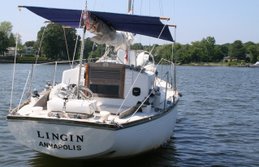The 2007 racing season is off to a great start! We started the season with nine Albergs racing in the Annapolis National Offshore One-Design (NOOD) regatta. The NOOD is a three day regatta that regularly sees over 250 boats in attendance racing in three divisions. For the Albergs this is also our Maple Leaf Trophy regatta. The winner of the NOOD receives a half-model of his or her boat--arguably the nicest trophy given by the association.
The conditions this year were frustrating at times, but overall the competitors had a great time. Friday saw such light winds that the only race that was started had to be abandoned before the racers completed the first upwind leg. The saving grace was that the torrential downpour that was coming down during breakfast thankfully stopped just as the boats left for the race course.
Saturday started by looking like a carbon copy of Friday: no wind. However, a little before lunch, the wind came marching out of the
The NOOD courses are always multiple laps around short windward—leeward courses. This produces fast races where good starts can make a big difference. Upwind strategy is important, taking current, wind pressure and oscillations into account all the way. Downwind, getting the spinnaker up quickly is vital to success, and depending on the wind pressure, deciding between a Rhumb line course and "tacking downwind" can be a tough decision one has to face. Since there are a lot of sail changes and transitions, crew work is action-packed--there's not much sitting on the rail in the NOOD. In fact, on my boat, our foredeckman wore a new watch that recorded his heart rate throughout the race. It was quite interesting to see his heart rate jump up at different points in the race--especially when he had to climb the mast to try to untangle a stuck spinnaker halyard!
Sunday brought with it steady wind that allowed two more races. I'll leave the sea stories to be told over beers at the next rendezvous by those who sailed in the boats.
It was tight racing with many boats in contention for silver throughout the weekend. T.C. Williams and his crew aboard Argo won the day through consistent speed and teamwork. Hats off to Argo! I've listed the overall results below.
Division: Alberg 30 (9 boats)
| Pos | Sail | Boat | Skipper | 1 | 2 | 3 | 4 | Total |
| 1 | 247 | Argo | T.C. Williams | 2 | 1 | 2 | 2 | 7.00 |
| 2 | 57 | Infinity | Charles Currier | 3 | 5 | 1 | 1 | 10.00 |
| 3 | 550 | Skybird | Rolph Townshend | 5 | 2 | 3 | 4 | 14.00 |
| 4 | 244 | LinGin | Tim Williams | 1 | 3 | 10/DNF | 3 | 17.00 |
| 5 | 562 | Windswept | Lanny Helms | 6 | 6 | 4 | 5 | 21.00 |
| 6 | 287 | Calliope | John Bergquist | 4 | 7 | 6 | 8 | 25.00 |
| 7 | 197 | Laughing Gull | Jonathan Adams | 7 | 4 | 7 | 7 | 25.00 |
| 8 | 567 | Andante | Andrew Cole | 9 | 8 | 5 | 9 | 31.00 |
| 9 | 484 | Second-2-Nun | Harry Gamber | 8 | 9 | 8 | 6 | 31.00 |
Depending on when you receive this letter, you may be able to join us for the Ted Osius Regatta on June 10th. This is an "around the bouys" race, meaning we don't end up at a destination at the end of the racing, so it lends itself to a nice simple day of racing. It's typically held right at the mouth of the
Beyond the Osius regatta, we Alberg racers take July and August off--and that's okay for me; there's rarely much wind and it is too hot!
--Tim Williams
